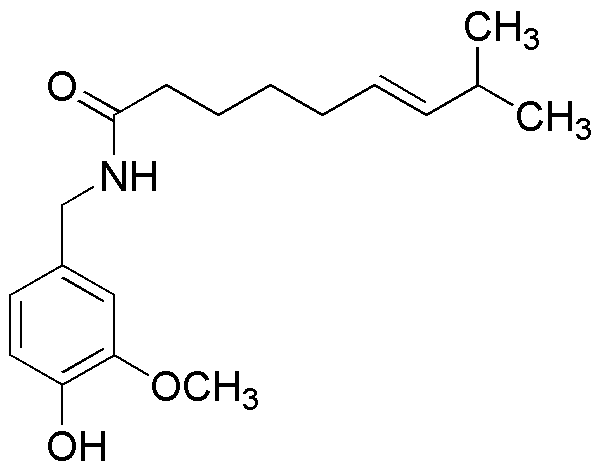Capsaicin is widely utilized in research focused on:
- Pain Relief: Capsaicin is a key ingredient in topical analgesics. It helps alleviate pain by desensitizing sensory neurons, making it effective for conditions like arthritis and neuropathic pain.
- Weight Management: This compound is often included in dietary supplements aimed at weight loss. It can boost metabolism and promote fat oxidation, making it a popular choice in weight management products.
- Food Industry: Capsaicin is used to enhance flavor in various food products. Its heat profile adds a unique taste to sauces, snacks, and marinades, appealing to consumers who enjoy spicy foods.
- Cosmetics: In skincare, capsaicin is included in formulations for its warming properties, which can improve blood circulation and promote a healthy glow. It's also found in products targeting cellulite.
- Research Applications: Capsaicin is a valuable tool in scientific studies exploring pain mechanisms, metabolism, and even cancer research, providing insights into various biological processes.
General Information
Properties
Safety and Regulations
Applications
Capsaicin is widely utilized in research focused on:
- Pain Relief: Capsaicin is a key ingredient in topical analgesics. It helps alleviate pain by desensitizing sensory neurons, making it effective for conditions like arthritis and neuropathic pain.
- Weight Management: This compound is often included in dietary supplements aimed at weight loss. It can boost metabolism and promote fat oxidation, making it a popular choice in weight management products.
- Food Industry: Capsaicin is used to enhance flavor in various food products. Its heat profile adds a unique taste to sauces, snacks, and marinades, appealing to consumers who enjoy spicy foods.
- Cosmetics: In skincare, capsaicin is included in formulations for its warming properties, which can improve blood circulation and promote a healthy glow. It's also found in products targeting cellulite.
- Research Applications: Capsaicin is a valuable tool in scientific studies exploring pain mechanisms, metabolism, and even cancer research, providing insights into various biological processes.
Documents
Safety Data Sheets (SDS)
The SDS provides comprehensive safety information on handling, storage, and disposal of the product.
Product Specification (PS)
The PS provides a comprehensive breakdown of the product’s properties, including chemical composition, physical state, purity, and storage requirements. It also details acceptable quality ranges and the product's intended applications.
Certificates of Analysis (COA)
Search for Certificates of Analysis (COA) by entering the products Lot Number. Lot and Batch Numbers can be found on a product’s label following the words ‘Lot’ or ‘Batch’.
*Catalog Number
*Lot Number
Certificates Of Origin (COO)
This COO confirms the country where the product was manufactured, and also details the materials and components used in it and whether it is derived from natural, synthetic, or other specific sources. This certificate may be required for customs, trade, and regulatory compliance.
*Catalog Number
*Lot Number
Safety Data Sheets (SDS)
The SDS provides comprehensive safety information on handling, storage, and disposal of the product.
DownloadProduct Specification (PS)
The PS provides a comprehensive breakdown of the product’s properties, including chemical composition, physical state, purity, and storage requirements. It also details acceptable quality ranges and the product's intended applications.
DownloadCertificates of Analysis (COA)
Search for Certificates of Analysis (COA) by entering the products Lot Number. Lot and Batch Numbers can be found on a product’s label following the words ‘Lot’ or ‘Batch’.
*Catalog Number
*Lot Number
Certificates Of Origin (COO)
This COO confirms the country where the product was manufactured, and also details the materials and components used in it and whether it is derived from natural, synthetic, or other specific sources. This certificate may be required for customs, trade, and regulatory compliance.


